Julieanna Preston – 4 May, 2023
At an event at Wellington's Sustainability Trust, I watched people tentatively touch and respond to the material, by making decorated pinch pots for plants, and overcoming any objection to its smell or origin. They warmed to Manju's infectious advocacy for the material's practical uses. Here was a substance that has been the source of an environmental argument between farmers and environmentalists: cows—the villains of freshwater pollution.
EyeContact Essay #49
Follow me. Imagine driving up a steep road on Miramar Peninsula, into a sky of moisture hanging heavy. At the pinnacle of the mount where the road ends, there is a staunchly walled structure bedazzled with barbed wire and graffiti, the now silent ruin of Mount Crawford Prison. The air is thick, as are the mosquitoes humming in sync like the tones of a cello’s strings, and the tender chatter of children wafting through the canopy. Following these sounds, we find, amongst the lush vegetation on the east-facing slope, a flourishing community garden; “…an award winning ‘micro urban farm’ offering a social network where members learn about growing fresh organic produce and healthy living.” (1.)
Our gumboots have proved their worth; the soft fertile soil responds to each foothold with a fecund sucking sound. A clearing with a table of food and drink is nestled amongst a maze of raised garden beds, beehives, a greenhouse, and people enjoying the event of “a pretty potluck picnic”, part of the Seeds for Feeds, a 2023 Wellington summer-long festival celebrating locally grown natural, community-building food. (2.) (Fig 1)
Wandering beyond this scene, we are repeatedly reminded of the enforced labour by prison inmates to build stone retaining walls that organise the landscape into irregular terraces; a labour of penitence. Our movement through the trees and brush is interrupted by steaming, piles of sweet-smelling entropy. We are led by well-trodden grass paths that blur the distinction between what are weeds and what are not. It is all just growing, growing well, growing wild but not quite feral.
There is a longer memory that belongs to this place before it was colonised. The peninsula was once an island known as Te Motu Kairangi, meaning “sky-gazing island”, and according to Adkin, a twentieth century amateur scholar, New Zealand farmer, geologist, archaeologist, ethnologist, photographer, and environmentalist, in the time of Tara (mid 1200s), was the place where Māori from Matiu resettled their pā, and a place known for its steep topography—”never a level place of flat, or plain to serve as a strolling place for the people” and hence, a view of the sky was never interrupted.(3.)
Accounts of pre-settlement history written by Elsdon Best, a notable New Zealand’s ethnographer of Māori social life and customs, outline the instructions Whatonga (the navigator and captain of the Kurahaupō waka and ancestor of Ngāi Tara) gave to his people on how to build a fortified village at the top of the heavily forested mainland mountain closest to Matiu. The pā, named Whetu-Kairangi, was to be surrounded by defensive stockades to protect people, storehouses and water sources, and all overgrown manuka and bush were to be burned regularly so intruders couldn’t burn the defences down. (4.)
Sadly the Mount Crawford Prison is on the same site as this fortified pā, which raises an existential quandary about that which keeps things in is also what keeps things out. More importantly is Whatonga’s mention of the site’s exposed and highly accessible position and the need to store more than enough food in case of attack. It may have been for the people to make place on these slopes, for it has been settled numerous times.
Amongst the shadows of a stand of manuka trees, white shapes pose in stark contrast to the dark brown floor of needles and leaves. Aberrant likenesses of over-sized mushrooms, totems, or the bulbous forms of cartoon ghosts become visible; their profiles contradict a close connection with their lime coated materiality: moulded, dried cow manure.
It’s necessary to set this scene to acknowledge land before it was turned into landscape, or mana whenua before it was turned into surveyed, fenced and deeded property. It also provides a context to a collaborative art work that despite false starts over several years, found a place that nurtured the artists’ ethical, sustainable, and creative ethos: to work with cow dung, an organic, plentiful, readily-available local material; to work together; to let the project emerge from community interaction, to mould sculptural objects by hand using objects found on site and in all kinds of weather. Its creators were met with many obstacles that would have seen most artists give up rather than persist against the myths and prejudices about what counts as art. This essay is concerned with the context and process of this art’s production as a labour of love to find place.
The artists are Manju Tomar and Ruth Robertson-Taylor. Their 2023 artwork at the Miramar Community Garden is a collection of sculptural objects entitled Habitat for Life.
Manju, a recent immigrant from India, moved to Aotearoa for postgraduate study and brought with her cultural knowledge about using cow dung as a material for building, insulating, ornamenting, and fuel. Her practical skills, perseverance and unsinkable optimism have been invaluable to forging networks amongst farmers, sustainable advocates, potters, environmentalists, and dirt-phobic nay-sayers. A classic quote from Manju: “Whether it is the feeling of oneness in the village with community, nature, and materials or the desire to help the future through community-based art, the underlying need is to experience the love of uniting with all.” (5.)
Ruth is a fifth generation Pākehā hailing from Ireland and a long term resident of Porirua. Operating under the name Gorse (6.), her practice is best described as a community-engaged social arts practice often focussed on the collaborative making of murals in public space, and it includes her leadership and facilitation of projects such as Frances Hodgkins Mural, He waka eke noa, and Weaving Hope (7.). A common thread through all her works can be summed up in her statement: “I refuse to give up on a common humanity, on solidarity”, an ethos that easily casts her as an honorary member of Miriam Issa’s permaculture garden and women’s circle RAW: Resilient Aspiring Women (8.). It is no surprise that she is currently part of the founding effort to establish a community garden in Porirua.
Habitat for Life has had numerous lives, or a single long life with a very complex gestation. The project started in 2020 with a Letting Space (9.) proposal to create handmade cow dung sculptures that would serve as micro-environments for birds and other wildlife in abandoned and under-used urban spaces. (Fig 2) Manju and Ruth imagined it as a site-specific multi-species sculptural sanctuary accompanied by a series of lectures and/or workshops on urban biodiversity. Though selected, the proposal found its way to the community arts advisors at Wellington City Council where it transformed into a relief mural work on the side of a container on Bond Street in the heart of the CBD.
After nearly a year lost to the complications of continuing to work during long isolated COVID thwarting periods, and health and safety, design and budget concerns, the project restarted from scratch to look for a new place. It became clear that the project demanded the artists shift their ambitions from thinking about the sculpture as site-specific to one more broadly immersed in place. It was just not meant to live in the concrete world of urban fabric amongst hygiene regulations and environments hostile to dirt. At this point, it looked feasible for the project to be located at Wellington Botanical Gardens as part of the visitor experience, perhaps even engaging visitors with the special material in the context of a horticultural atmosphere, and not the urban one.
Noting the fact that the Botanical Gardens sit on land stolen from Māori by colonial settlers, the new proposal imagined making large cow dung sculptural bowls filled with native plants to be gifted to local iwi, along with bits of colourful wool mixed with cow dung that could be wrapped where a gardener had pruned a plant. (10.) (Fig 3) These were envisaged to be symbolic gestures to heal wounds. Alas, this proposal also was rejected when the artists realised that their ideas of envisioning the sculptural work as educative did not match those of their host organisation. The search for a location continued
It’s now 2023. The pandemic, though not over, has subsided, and on the surface, life has started to return to some semblance of normalcy. Manju and Ruth are not deterred or disillusioned. In mid-2022 they were invited to take up an artists’ residency at the Miramar Prison Garden (more fondly called Miramar Community Garden). The Garden’s relationship to the prison and the pā are ever-present. Here the artists found themselves surrounded by kindred spirits who had the soil of the land in their pores, between their toes and under their nails. None of them have any qualms about doing hard work.
The months ahead were an industrious and absurd form of comedy. Imagine two women leading a group through the rage of a storm to the slopes of a neighbouring farm to collect manure pats. (Fig.4) Their modest haul filled a greenhouse with a pungent grass and urine stink. Having outgrown the small privy-like tool shed originally allocated as a studio, the greenhouse was propagating cow dung forms moulded from various ‘junk’ found around the garden: cogs, umbrellas, bowls, and buckets. (Fig. 5)
When spring arrived, the greenhouse was needed for seedlings and Ruth and Manju found themselves improvising with tarps, ropes and discarded corrugated tin to make a bivouac. (Fig.6) On my first visit, when they flipped the tarp flap open, a cloud of frenzied insects veiled stacks of white plate and bulbous-like forms positioned between vats of lime paste and half-dried dung cakes. (Fig.7)
Lime, they had learned, was good for the soil, and an antidote to Wellington’s wet and temperate climate where drying clothes, let alone manure cakes, was wishful thinking. A coat of lime extends the life of the dried dung forms, and paints them ‘a bit of pretty.’ (Fig. 8) Manju’s and Ruth’s determination to make this artwork on, of and with place, under less than ideal circumstances, was ingenious.
At an event at Wellington’s Sustainability Trust, I watched people tentatively touch and respond to the material, by making decorated pinch pots for plants, and overcoming any objection to its smell or origin. (Fig. 9 - 10) They warmed to Manju’s infectious advocacy for the material’s practical uses. Here was a substance that has been the source of an environmental argument between farmers and environmentalists: cows—the villains of freshwater pollution.
If that is not enough, both Māori and Pākehā have very strong attitudes and protocols around animal waste, especially its use near the production of food. Considering it repugnant, early Māori never used manure as fertiliser “probably stemming from their belief that the Earth Mother, Papa, provided food, and it would be unwise to offend her by using something ‘unclean’.” (11.)
Like many who fall under the spell of sustainability and its heightened urgency in regard to climate change, I wonder what I as an individual can do to effect change. This admission of my own glass-half-empty outlook was dashed when watching the short film that documents Manju and Ruth’s making process. (12.) Here we find the disgusting aspect of this mustard-brown slurry transformed into habitats for wildlife. We find artists collaborating as ‘artivists’ who—thanks to Manju’s grandmother who showed her how to work the material—now advocate it to be reconsidered as a useful resource rather than a waste material. And showing, in Manju’s and Ruth’s words: “How Cow Poop Can Save the World.”
While most art essays consider the artwork to be a stand-alone object, this article considers numerous other factors to be keys to its making. I differentiate between that which is hard work (i.e. challenging toil) and that which is labour (as in creation, birthing, and gestational), or unpaid invisible labour, much of which is maintenance of the home, usually by women.
The relation between art and labour is more for an artist to labour elsewhere as a means of being able to afford to do art, or rely heavily (yet frequently unsuccessfully) on grants and awards to keep their practice going. My intention is also to highlight the labour that is accumulative through the iterative gestures that the artists bring toward by tending a project as it morphs, responds and shifts to distant and local influences. We could calculate their hourly rate from the Council funding they were initially awarded, and the in-kind donations of materials, space and time for consultation, though I suspect that calculation would result in a negative number.
Rarely is the question asked: How much love did the artists expend in making their art work? This is a curious question on which to muse because: 1) it recognises love as a key ingredient to whatever art-making recipe one generates; 2) it is hardly measurable (except in its absence); 3) it is subtlety recognisable (so, maybe on the verge of being invisible); and 4) it evades quantification because it is either limitless or as soon as it becomes diminished, its self-organising, positive virus-like agency is replenished, magically. Here I am reminded of the European folk story Stone Soup credited to Madame de Noyer of France in 1720, in which strangers come to a farmhouse and convince the children left at home alone that they can make a soup from a special stone. A pot of water is put on the fire, the stone slipped into the pot, and while waiting for it to boil, this and that ingredients are added by all the nearby villagers who have gathered (13.). Made through gestures of love, generosity and sharing, everyone has a good time together, and the soup is fantastic.
There remains a last note to this essay. The fate of the Miramar Community Gardens is tied up with the 2016 Treaty Settlement made by Taranaki Whānui ki Te Upoko o Te Ika / Port Nicholson Block Trust in which The Crown returned land between Marukaikuru/ Shelly Bay and Mātai Moana/ Mt Crawford to the Taranaki iwi Te Atiawa, acknowledged for being established in the region. (14.) Since that settlement, a proposal has been put forward for fast-track consent to build an intensive housing development. (15.) The arguments on all sides are passionate, and it is telling at just how far Aotearoa has to go before Te Tiriti-led becomes a palpable action rather than a merely potential aspiration. These are the times and the place we live in.
Note that Habitat for Life may in fact be an unintentional and symbolic gesture that finds itself deteriorating into the soil, leaving barely a trace except as organic mineral matter seeping into the soil and flowing down the steep slopes to meet the sea. I would call that an appropriate form of poetic justice. Large vessels made of cow dung filled with native plants may only scratch the surface of the wounds of hearts and land, but knowing the powers of growing and sharing food as we do in Aotearoa—what an opportunity to make some Stone Soup.
Julieanna Preston
(1.) https://www.miramarfl.gov/501/Community-Garden
(2.) https://www.seedstofeeds.nz/
(3.) George Leslie Adkin. The Great Harbour of Tara, p. 43, https://wellington.recollect.co.nz/nodes/view/4057#idx6790
(4.) Elsdon Best. The Land of Tara and They who Settled It, Settlement of the Wellington District, p. 13, https://www.wcl.govt.nz/maori/wellington/landoftara2.html
(5.) Tomar. (2021). Weaving Earth Stories. Massey University MFA exegesis, http://hdl.handle.net/10179/17288.
(6.) https://www.gorsestreetart.com/about
(7.) Robertson Taylor. (2021). Weaving Hope, Massey University MFA exegesis, https://mro.massey.ac.nz/handle/10179/17047.
(8.) Robertson Taylor, 11-13.
(9.) Letting Space, https://www.lettingspace.org.nz/
(10.) Manju tells of how in Bihar, India, trees are painted with sacred images to protect them from being cut down.
(11.) http://www.nzsoils.org.nz/Topic-Basics_Of_Soils/Maori_and_Soils/
(12.) Readers are encouraged to watch the film which was made by Hannah Gower in 2022. https://vimeo.com/806999216
(14.) https://www.legislation.govt.nz/act/public/2016/0094/latest/DLM6460015.html
(15.) For a very brief over view, see https://wellington.scoop.co.nz/?p=151284
(16.) On behalf of the artists, I wish to acknowledge the gifts of time, material, labour and knowledge towards the making of “Habitat for Life”: Wellington City Council for funding, Miramar Prison Garden and Farm, Patty Zais, Milan Magan, Hannah Gower for film, Tim Barlow for lime, Steven Cameron, Ariki George, Wellington East Girls College Duke of Edinburgh Award students and Izzy and Annike for bamboo.
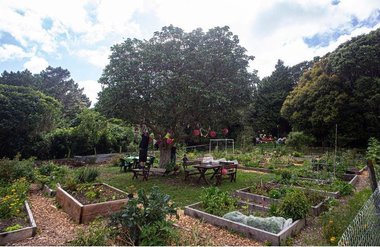

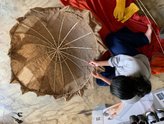
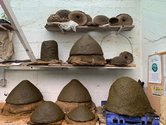
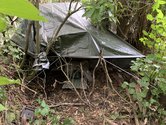
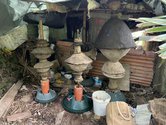
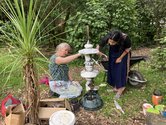
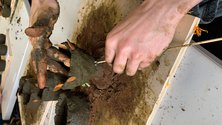


 Advertising in this column
Advertising in this column Two Rooms presents a program of residencies and projects
Two Rooms presents a program of residencies and projects
This Discussion has 0 comments.
Comment
Participate
Register to Participate.
Sign in
Sign in to an existing account.